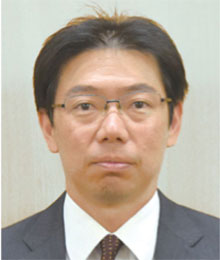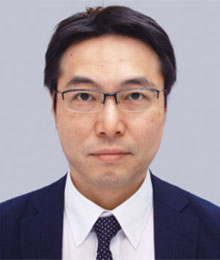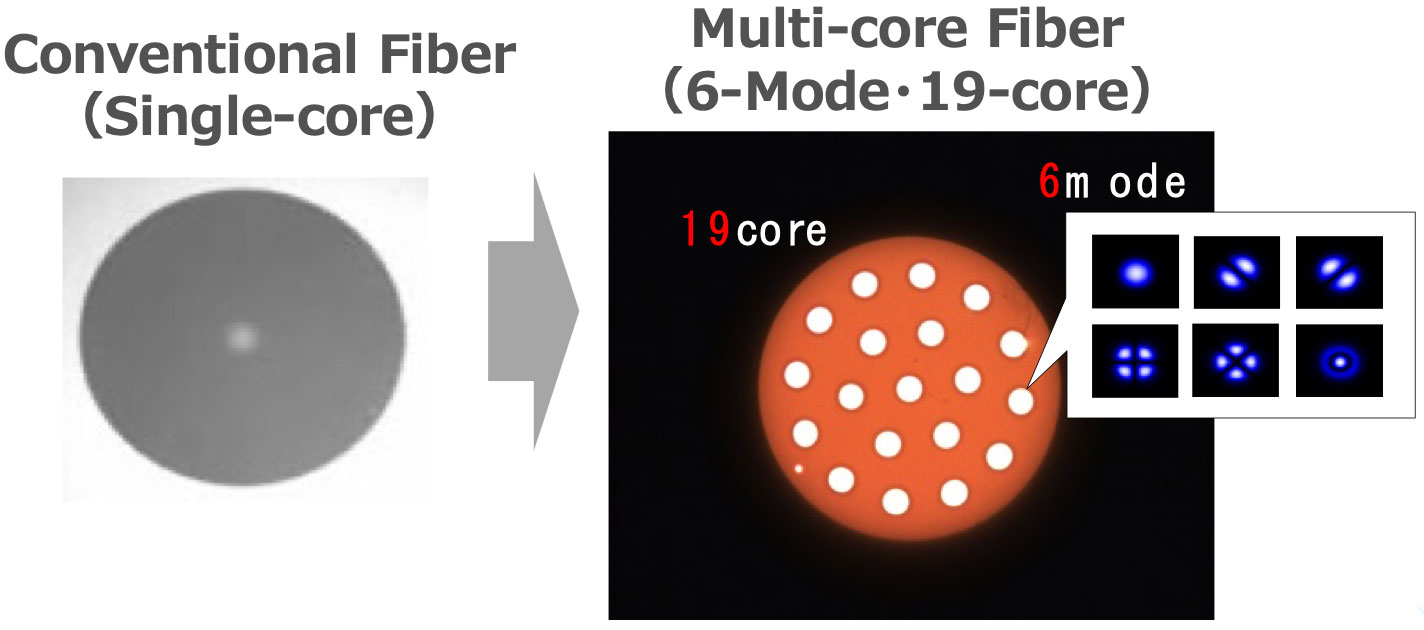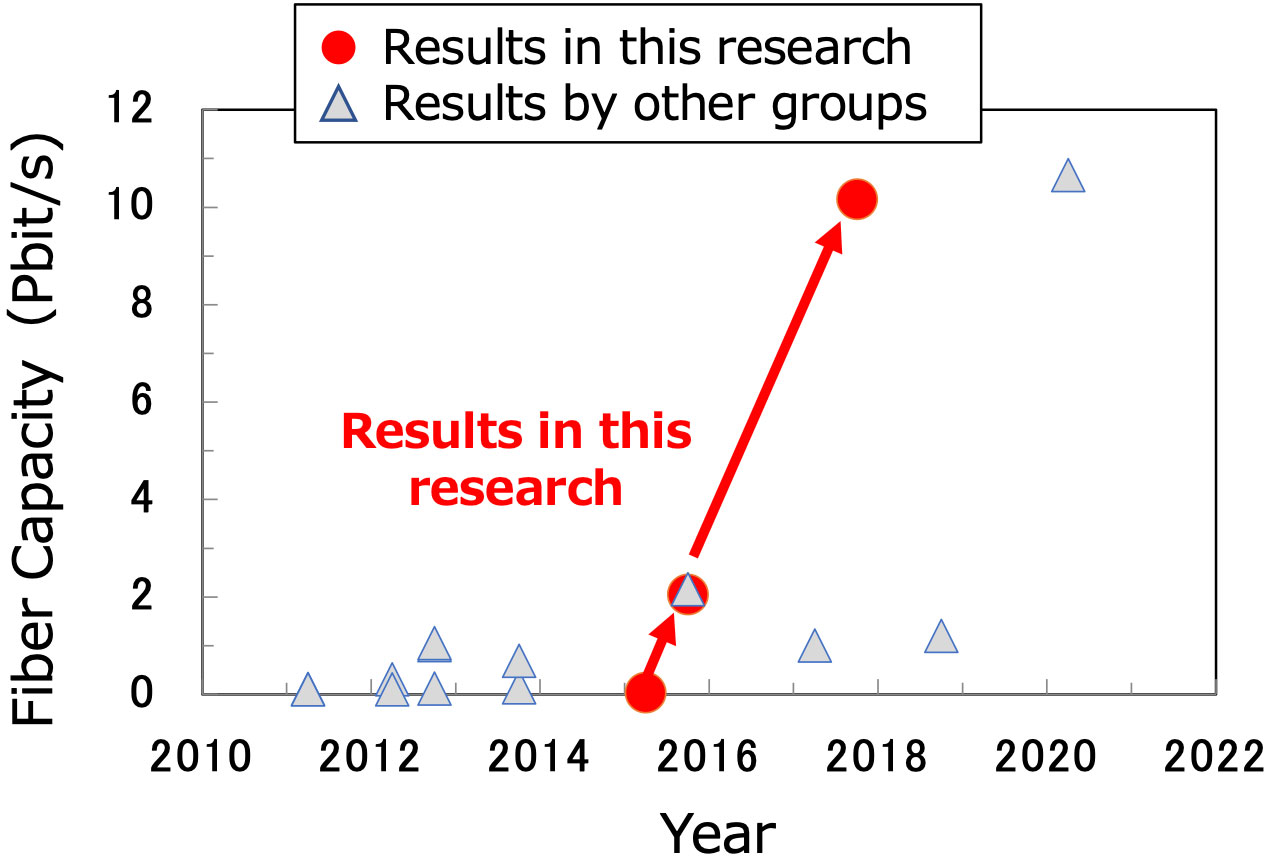Achievement Award
Pioneering research on 10 Pbit/s-class ultra-high capacity space division multiplexing transmission technologies



In order to provide broadband and high-quality communication services such as video distribution with Internet and 5G mobile communication, optical communication systems must have the ability to provide scalable capacity on demand as communication infrastructure. However, it has been found that conventional optical communication systems with conventional single-core fibers have a physical limitation of capacity around 100 Tbit/s due to the upper limit of fiber launch power. Since this value is only 10 times the system capacity of the latest commercial systems and insufficient considering that the annual growth rate of communication traffic is around 40%, extremely advanced technologies to break through this capacity limit of conventional fibers were required.
Under such a situation, the study of space division multiplexing (SDM) using multi-core fiber (MCF) and/or multi-mode fiber started all over the world around 2010 [1]. The award recipients started their pioneering study on SDM technologies after clarifying the limitation of the conventional technologies [2], and experimentally demonstrated the feasibility of proportional capacity expansion with the number of cores in the crosstalk suppressed MCF in the world’s first transoceanic distance transmission [3] and high-capacity transmission with the largest capacity distance product of over 1 Ebit/s・km [4]. Then, they introduced multi-mode MCF (MM-MCF) to further increase spatial multiplexity and demonstrated high-capacity transmission with MM-MCF as shown in Fig. 1 [5, 6]. In 2017 they successfully achieved the world’s first 10 Pbit/s transmission by employing the 6-mode and 19-core fiber [6]. The achieved capacity corresponded to about 1000 times the latest commercial systems and about 100 times the record in laboratory experiments with conventional single-core fibers. These results clearly showed the effectiveness of the new orthogonal multiplexing dimension of “space” added to the conventional dimensions such as “time”, “polarization”, “frequency” and “quadrature amplitude” for continuous and significant capacity expansion. In addition, considering compatibility with existing optical communication systems, the recipients investigated MCFs with a standard cladding diameter of conventional single-core fiber for early commercialization and conducted field tests of the installed MCF cables [7] and ultra-long-haul transmission experiments over 10000 km [8] with the optimized MCF for standard cladding.


The award recipients have promoted the study of SDM from its early stages and led global research by showing the potential of MCF in successive world first demonstrations. Their achievements are highly evaluated as pioneering research to show the feasibility of the sustainable growth of optical communication systems and each of the recipients has been invited to many major academic conferences. Currently SDM is recognized as one of the leading technologies for ultra-high-capacity transmission, which shows the achievements by the award recipients are remarkable and that they have had a large influence on the research community.
In summary, the achievements of the award recipients are remarkable and they definitely deserve the IEICE Achievement Award.
References
- M. Nakazawa, M. Suzuki and T. Morioka, “Innovation in Optical Fiber Communication Technologies”, Optronics, 2012.
- I. Morita and M. Suzuki, “Innovations for Future Optical Submarine Cable Systems,” OECC2010, 6B2-4, 2010.
- H. Takahashi, T. Tsuritani, E. L. T. de Gabory, T. Ito, W-R Peng, K. Igarashi, K. Takeshima, Y. Kawaguchi, I. Morita, Y. Tsuchida, Y. Mimura, K. Maeda, T. Saito, K. Watanabe, K. Imamura, R. Sugizaki and M. Suzuki, “First Demonstration of MC-EDFA-Repeatered SDM Transmission of 40 x 128-Gbit/s PDM-QPSK Signals per Core over 6,160-km 7-core MCF,” ECOC2012, Th3C.3, 2012.
- K. Igarashi, T. Tsuritani, I. Morita, Y. Tsuchida, K. Maeda, M. Tadakuma, T. Saito, K. Watanabe, K. Imamura, R. Sugizaki and M. Suzuki, “1.03-Exabit/skm Super-Nyquist-WDM transmission over 7,326-km seven-core fiber,” ECOC2013, PD3.E.3, 2013.
- D. Soma, K. Igarashi, Y. Wakayama, K. Takeshima, Y. Kawaguchi, N. Yoshikane, T. Tsuritani, I. Morita and M. Suzuki, “2.05 Peta-bit/s super-nyquist-WDM SDM transmission using 9.8-km 6-mode 19-core fiber in full C band,” ECOC2015, PDP3.2, 2015.
- D. Soma, Y. Wakayama, S. Beppu, S. Sumita, T. Tsuritani, T. Hayashi, T. Nagashima, M. Suzuki, H. Takahashi, K. Igarashi, I. Morita and M. Suzuki, “10.16 peta-bit/s dense SDM/WDM transmission over low-DMD 6-mode 19-core fibre across C+ L band,” ECOC2017, Th.PDP.A.1, 2017.
- T. Tsuritani, D. Soma, Y. Wakayama, Y. Miyagawa, M. Takahashi, I. Morita, K. Maeda, K. Kawasaki, T. Matsuura, M. Tsukamoto and R. Sugizaki, “Field Test of Installed High-Density Optical Fiber Cable with Multi-Core Fibers toward Practical Deployment,” OFC2019, M3J.4, 2019.
- D. Soma, S. Beppu, H. Takahashi, N. Yoshikane, I. Morita, T. Tsuritan, “Performance Comparison of Standard Cladding Ultra-Low-Loss Uncoupled and Coupled 4-Core Fibres Transmission over 15,000 km,” ECOC2020, Mo2E.4, 2020.